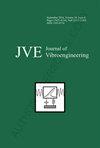不同轨道结构对地铁小半径曲线区段波纹发展的影响
IF 0.9
Q4 ENGINEERING, MECHANICAL
引用次数: 1
摘要
大量研究表明,地铁浮板轨道小半径曲线段的轨道波纹严重。它似乎不同于普通轨道上的轨道波纹。轨道结构在轨道波纹的产生和发展中起着重要的作用。本文对天津某地铁线路进行了实测,包括2种不同的轨道结构,并采用轨道波纹的国际评价和验收指标对实测数据进行了分析。结果表明:短枕单片轨道(SSMT)内轨在0 ~ 300 mm波长范围内光滑度较差,外轨整体光滑度较好;钢弹簧浮板轨道(SSFST)的内轨在100- 300mm波长范围内光滑度较差,外轨在300- 1000mm波长范围内光滑度较差。然后建立了车轨耦合模型和轮轨磨损计算模型。计算结果表明,在现有轨纹中,20 ~ 25 mm短波长的轨纹将继续出现或恶化,其他波长的轨纹发展将不同程度地减缓或停止;随着列车通过次数的增加,波长为315 mm的SSFST轨道波纹发展最快,波长为20 mm和160 mm的SSMT轨道波纹发展最快。本文章由计算机程序翻译,如有差异,请以英文原文为准。
Influence of different track structures on the development of corrugation in small radius curve section of subway
Many studies have shown that the rail corrugation on the small radius curve section of subway floating slab track is serious. And it seems to be different from the rail corrugation on the common track. The track structure must play an important role in the generation and development of rail corrugation. This paper measured a subway line in Tianjin, including 2 different track structures, and analyzed the measured data by using the international evaluation and acceptance indexes of rail corrugation. The results show that the inner rail of short sleeper monolithic track (SSMT) has poor smoothness in the wavelength range of 0-300 mm, and the overall smoothness of outer rail is good; the inner rail of steel spring floating slab track (SSFST) has poor smoothness in the wavelength range of 100-300 mm, and the outer rail has poor smoothness in the wavelength range of 300-1000 mm. Then the vehicle-track coupling model and wheel-rail wear calculation model is established. The calculation results show that in the existing rail corrugation, the short-wavelength rail corrugation of 20-25 mm will continue to appear or deteriorate, and the development of rail corrugation of other wavelengths will slow down or stop to varying degrees; with the increase of train passing times, the rail corrugation of SSFST with the wavelength of 315 mm develops the fastest, and the rail corrugation of SSMT with wavelengths of 20 mm and 160 mm develops the fastest.
求助全文
通过发布文献求助,成功后即可免费获取论文全文。
去求助
来源期刊

Journal of Vibroengineering
工程技术-工程:机械
CiteScore
1.70
自引率
0.00%
发文量
97
审稿时长
4.5 months
期刊介绍:
Journal of VIBROENGINEERING (JVE) ISSN 1392-8716 is a prestigious peer reviewed International Journal specializing in theoretical and practical aspects of Vibration Engineering. It is indexed in ESCI and other major databases. Published every 1.5 months (8 times yearly), the journal attracts attention from the International Engineering Community.
 求助内容:
求助内容: 应助结果提醒方式:
应助结果提醒方式:


